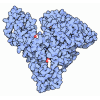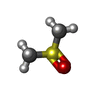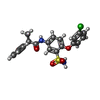Entry Database : PDB / ID : 6htyTitle PXR in complex with P2X4 inhibitor compound 25 Nuclear receptor subfamily 1 group I member 2,Nuclear receptor coactivator 1 Keywords / / / Function / homology Function Domain/homology Component
/ / / / / / / / / / / / / / / / / / / / / / / / / / / / / / / / / / / / / / / / / / / / / / / / / / / / / / / / / / / / / / / / / / / / / / / / / / / / / / / / / / / / / / / / / / / / / / / / / / / / / / / / / / / / / / / / / / / / / / / / / / / / / / / / / / / / / / / / / / / / / / / / / / / / Biological species Homo sapiens (human)Method / / / Resolution : 2.22 Å Authors Hillig, R.C. / Puetter, V. / Werner, S. / Mesch, S. / Laux-Biehlmann, A. / Braeuer, N. / Dahloef, H. / Klint, J. / ter Laak, A. / Pook, E. ...Hillig, R.C. / Puetter, V. / Werner, S. / Mesch, S. / Laux-Biehlmann, A. / Braeuer, N. / Dahloef, H. / Klint, J. / ter Laak, A. / Pook, E. / Neagoe, I. / Nubbemeyer, R. / Schulz, S. Journal : J.Med.Chem. / Year : 2019Title : Discovery and Characterization of the Potent and Selective P2X4 InhibitorN-[4-(3-Chlorophenoxy)-3-sulfamoylphenyl]-2-phenylacetamide (BAY-1797) and Structure-Guided Amelioration of Its CYP3A4 Induction Profile.Authors: Werner, S. / Mesch, S. / Hillig, R.C. / Ter Laak, A. / Klint, J. / Neagoe, I. / Laux-Biehlmann, A. / Dahllof, H. / Brauer, N. / Puetter, V. / Nubbemeyer, R. / Schulz, S. / Bairlein, M. / ... Authors : Werner, S. / Mesch, S. / Hillig, R.C. / Ter Laak, A. / Klint, J. / Neagoe, I. / Laux-Biehlmann, A. / Dahllof, H. / Brauer, N. / Puetter, V. / Nubbemeyer, R. / Schulz, S. / Bairlein, M. / Zollner, T.M. / Steinmeyer, A. History Deposition Oct 5, 2018 Deposition site / Processing site Revision 1.0 Dec 4, 2019 Provider / Type Revision 1.1 Jan 8, 2020 Group / Category / citation_authorItem _citation.journal_volume / _citation.page_first ... _citation.journal_volume / _citation.page_first / _citation.page_last / _citation.title / _citation_author.name Revision 1.2 Jan 24, 2024 Group / Database references / Refinement descriptionCategory chem_comp_atom / chem_comp_bond ... chem_comp_atom / chem_comp_bond / database_2 / pdbx_initial_refinement_model / struct_ncs_dom_lim Item _database_2.pdbx_DOI / _database_2.pdbx_database_accession ... _database_2.pdbx_DOI / _database_2.pdbx_database_accession / _struct_ncs_dom_lim.beg_auth_comp_id / _struct_ncs_dom_lim.beg_label_asym_id / _struct_ncs_dom_lim.beg_label_comp_id / _struct_ncs_dom_lim.beg_label_seq_id / _struct_ncs_dom_lim.end_auth_comp_id / _struct_ncs_dom_lim.end_label_asym_id / _struct_ncs_dom_lim.end_label_comp_id / _struct_ncs_dom_lim.end_label_seq_id
Show all Show less
 Open data
Open data Basic information
Basic information Components
Components Keywords
Keywords Function and homology information
Function and homology information Homo sapiens (human)
Homo sapiens (human) X-RAY DIFFRACTION /
X-RAY DIFFRACTION /  SYNCHROTRON /
SYNCHROTRON /  FOURIER SYNTHESIS / Resolution: 2.22 Å
FOURIER SYNTHESIS / Resolution: 2.22 Å  Authors
Authors Citation
Citation Journal: J.Med.Chem. / Year: 2019
Journal: J.Med.Chem. / Year: 2019 Structure visualization
Structure visualization Molmil
Molmil Jmol/JSmol
Jmol/JSmol Downloads & links
Downloads & links Download
Download 6hty.cif.gz
6hty.cif.gz PDBx/mmCIF format
PDBx/mmCIF format pdb6hty.ent.gz
pdb6hty.ent.gz PDB format
PDB format 6hty.json.gz
6hty.json.gz PDBx/mmJSON format
PDBx/mmJSON format Other downloads
Other downloads 6hty_validation.pdf.gz
6hty_validation.pdf.gz wwPDB validaton report
wwPDB validaton report 6hty_full_validation.pdf.gz
6hty_full_validation.pdf.gz 6hty_validation.xml.gz
6hty_validation.xml.gz 6hty_validation.cif.gz
6hty_validation.cif.gz https://data.pdbj.org/pub/pdb/validation_reports/ht/6hty
https://data.pdbj.org/pub/pdb/validation_reports/ht/6hty ftp://data.pdbj.org/pub/pdb/validation_reports/ht/6hty
ftp://data.pdbj.org/pub/pdb/validation_reports/ht/6hty
 Links
Links Assembly
Assembly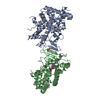
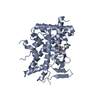

 Components
Components Homo sapiens (human) / Gene: NR1I2, PXR, NCOA1, BHLHE74, SRC1 / Production host:
Homo sapiens (human) / Gene: NR1I2, PXR, NCOA1, BHLHE74, SRC1 / Production host: 
 X-RAY DIFFRACTION / Number of used crystals: 1
X-RAY DIFFRACTION / Number of used crystals: 1  Sample preparation
Sample preparation SYNCHROTRON / Site:
SYNCHROTRON / Site:  BESSY
BESSY  / Beamline: 14.1 / Wavelength: 1.040432 Å
/ Beamline: 14.1 / Wavelength: 1.040432 Å Processing
Processing FOURIER SYNTHESIS
FOURIER SYNTHESIS Movie
Movie Controller
Controller





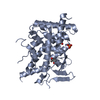

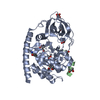
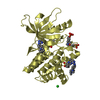
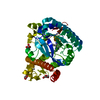



 PDBj
PDBj






